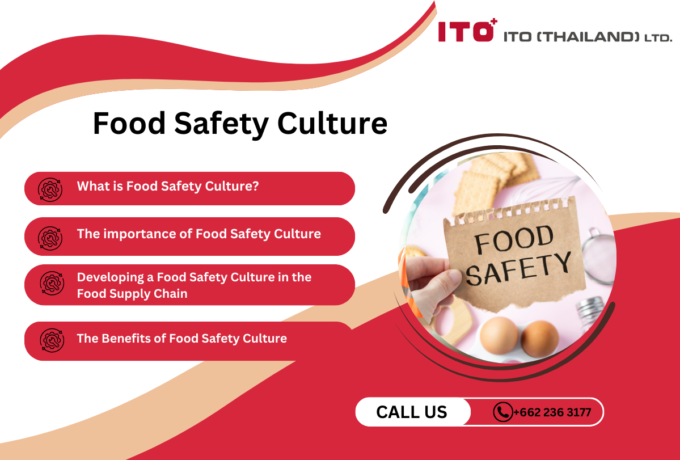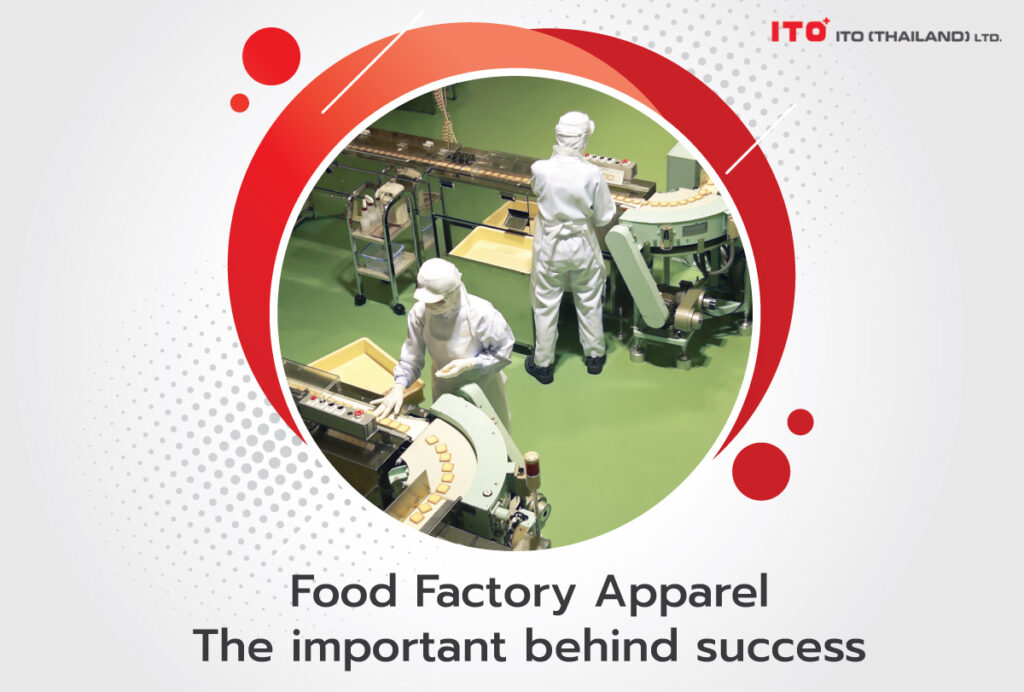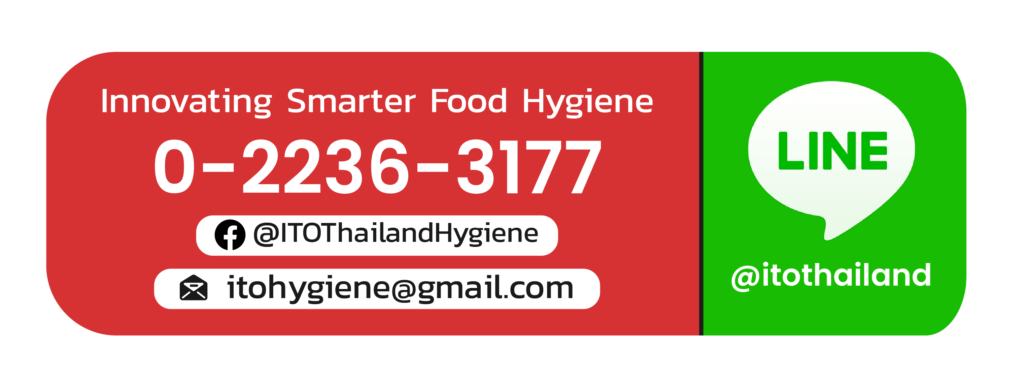ITO Thailand Hygiene Blog
Food Factory Apparel: The importance behind the success
Basic apparel according to GMP or GHP standards has similar content: it must be intended to protect against contamination from the operators, such as caps to prevent hair contamination, masks to prevent contamination from the facial hairs, saliva, particles from breathing, long-sleeved shirts with long legs without buttons or parts that are vulnerable to contamination, no pockets above the torso or chest range (as the content in the pockets may fall during the production process), aprons, gloves. Shoes are also replaced to suit the production process area and prevent external contamination. The apparel worn in the production area should not be worn outside the designated area. The areas should be separated according to the risk level, such as the raw material zone, packing zone, allergen zones, etc.
Colors or characteristics of apparel should be different to allow supervisors to observe if employees are mixed up. This can prevent cross-contamination. It is the responsibility of the operators to provide facilities such as a locker, the changing rooms, which are sufficient for the number of employees, and the condition of the apparel damage is checked. Additional measures, if necessary, must be in place, such as rollers, hair suction machines, etc. equipment for cleaning and disinfecting shoes, etc.
More details of the apparel are not clearly defined in the standard, or it can be assumed as depending on the suitability of each organization since the details of the food and production process are different. However, Dr. Baroudi from the Food Safety Institute (FSI) International in the United States [1] has suggested that apparel should be part of the HACCP system in food factories with the following advice on apparel in the industry:
– Apparel materials and designs must be appropriate, durable. The fabric is not flaky, does not trap dust, must not have buttons or parts that are easily dislodged. There should be no pockets because it is difficult to clean and may accumulate contaminants.
– The apparel must be readily clean at the beginning of the work shift and replaced when dirty or as appropriate.
– Efficiency in cleaning and disinfecting microorganisms in apparel cleaning using physical methods such as using at least 71 degrees Celsius of hot water for 25 minutes and chemical methods such as cleaning agents, soaps to remove stains and microorganisms. Chlorine of 50-150 ppm can be used to help bleach and disinfect. and in the final stages, soft acids may be added to quickly neutralize the cleaning agent and can suppress microorganisms.
– Heat drying can help protect against microorganisms.
The process of cleaning the apparel should be orderly and taken in steps. Start from separating types of clothing by the level of dirtiness. Then, clean the stains and dirt initially, soak the apparel, clean with surfactants, wash the surfactants (additional disinfectants may be added depending on the need), then dry by drying or drying with hot air. The washing must be in one direction. There is no mixing between clean and dirty clothes to prevent contamination.
Nowadays, in other countries such as Japan, there are industrial cleaning services, which reduce the burden on the organization to provide the facility and cleaning equipment. The services also have better cleaning efficiency than holding the operators responsible for their personal items. They may not be interested in cleaning, and there may be more external contamination. Research in the United States [2] has discovered that it is difficult for cleaning at home to meet the requirements of the organization since employees wear only one set of apparel a day. It is not worth washing every day because they have worked hard all day, or sometimes overtime. With the amount of clothes in a day, it is not worth paying and putting effort into washing. So, they wash clothes about once a week. Sometimes they may repeat the apparel because they wear the same outfit every day. Furthermore, factors within families (the employees living alone, with families, the presence of children or elderly people in the family) and the economic factors of the employees also affect the care to maintain the cleanliness of the staff apparel. Employees who do not earn enough or have debt problems may not be able to provide enough clean apparel for every working day and still must bear the cost of cleaning it. Therefore, sometimes the apparel is not cleaned thoroughly, and the employees will wear clothes that are not clean enough into the production part of the factory. These problems are often overlooked by executives or decision-makers in the organization, especially in Thailand, where it is preferred that employees take responsibility for their outfits. This can cause contamination from the apparel, especially organizations with hundreds of manufacturing employees.
These weaknesses may be improved by establishing a centralized laundry unit and with directly responsible employees to keep the employees’ apparel always up to standard. The washing machines, drying machines, and irons should be industrial level with the ability to generate heat and disinfect germs on the cloth and accommodate a large volume of clothes.
In addition to apparel, the shoes used in the production (usually waterproof rubber boots) are also a priority for cleanliness and disinfection. The shoes should be separated from shoes for outside and must not be taken out of the production area. The shoes should be cleaned and dried before the start of the operation, and they must be cleaned again before entering the operation, such as dipping them in a well containing disinfectants, using automatic washing and disinfecting machines, walking on adhesive carpets to trap dust, etc.
Attention to detail, even at a point that people in general may overlook, is one of the keys to success that Ito Thailand adheres to and encourages the food industry in Thailand to raise food safety standards and competitiveness in the international markets.
References
1.Baroudi, A. (2007). A Uniform Approach to HACCP. TEXTILE RENTAL, 90(8), 64.
2.Clayton, M. L., Clegg Smith, K., Neff, R. A., Pollack, K.M., & Ensminger, M. (2015). Listening to food workers: Factors that impact proper health and hygiene practice in food service. International journal of occupational and environmental health, 21(4), 314-327.
Related Post
-

Food Safety Culture
Food safety culture plays a crucial role in safeguarding the company's reputation, ensuring the well-being of its employees, and providing a safe experience for its customers.
-

New food source safety issues
What are safety issues worth knowing for trendy new food sources like plant-based and insect-based proteins?
-

British Retail Consortium (BRC) Standard
Food safety management systems play a vital role in ensuring the production and distribution of safe and high-quality food products to consumers. With the global food supply chain becoming increasingly complex, food businesses must implement effective systems prioritising safety, quality, and compliance with industry standards. A food safety management system encompasses a set of procedures, processes, and controls designed to identify, prevent, and manage potential hazards at every stage of the food production and supply process. This proactive approach not only safeguards consumers' health but also protects the reputation and credibility of food companies in an ever more competitive market.
-

Food Science in the World of Food Gastronomy (Part 1)
How can food science be applied to create new dishes?
-

FSSC 22000
Food manufacturers must ensure food safety standards and processes. FSSC 22000 is an official certification program for Food Safety Management Systems (FSMS) recognised by the Global Food Safety Initiative (GFSI). This certification scheme offers a set of guidelines and procedures to ensure uniformity, openness, and safety across your entire supply chain. It applies to all companies operating within the food and beverage industry, ranging from farmers to retailers. By fulfilling the necessary criteria and obtaining FSSC 22000 certification, it is demonstrated that the required standards for food quality and implementing effective processes to manage and mitigate risks associated with food fraud, foodborne illnesses, expensive recalls, and other external threats are met.
-

Food Safety Aspects of Artificial Sweeteners
Artificial sweeteners, also known as sugar substitutes, non-nutritive sweeteners, or high-intensity sweeteners, are artificially produced compounds utilised in place of sucrose (table sugar) to add sweetness to food and drinks. Due to their significantly higher sweetness than regular sugar, only a fraction of artificial sweeteners (200 to 20,000 times less) is required to achieve an equivalent level of sweetness. Since the caloric contribution of these sweeteners, when used in such small quantities, is insignificant, they are often referred to as non-nutritive (4).










